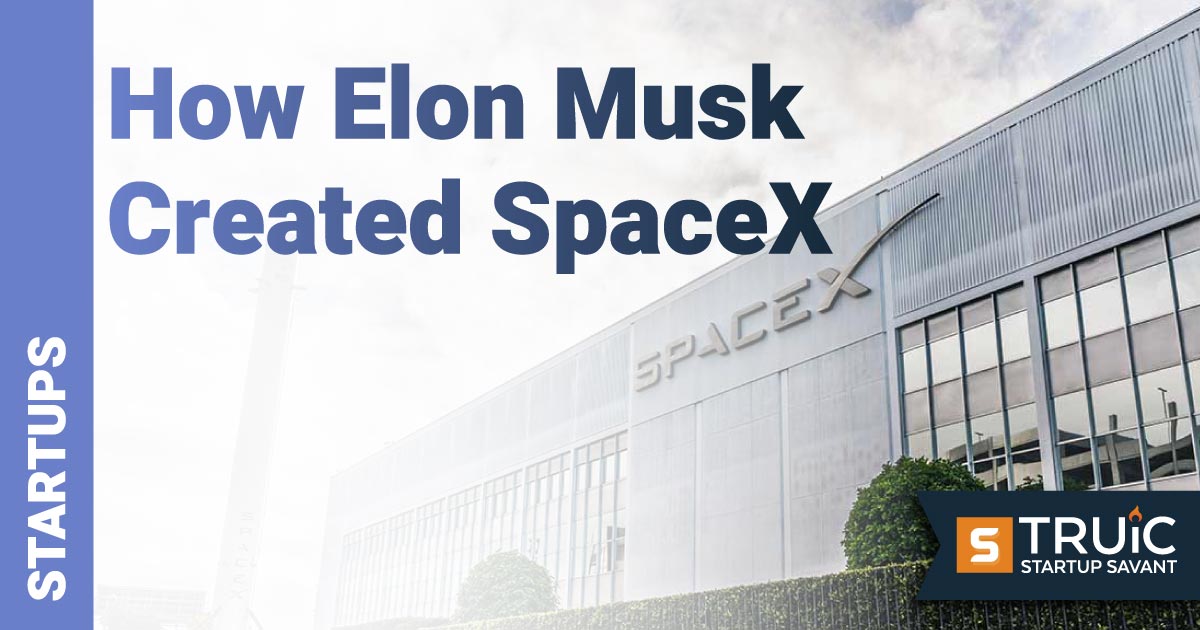How Elon Musk Created His Space Startup SpaceX

Last Updated: By TRUiC Team
Elon Musk always had an appetite for computers, technology, and reading and was often regarded as remarkably curious for his age. After starting to write computer software before his teenage years, his curiosity began to stretch into the realms of science and technology, trying to come up with ways he could change the world.
Musk has often been described as having ambition that was unlike anything else, constantly taking on new and more complex challenges and always seeking to fulfill his mind with seemingly endless problem-solving. After founding Zip2 in 1995 and selling it to Compaq Computer for $300 million in 1999, Elon Musk founded X.com, a financial services company. After a number of mergers, X.com was rebranded as PayPal.
In 2002, PayPal was sold to eBay for a staggering $1.5 billion, leaving Musk with $160 million to pursue his dreams of space exploration. Once Musk had the ability to begin breaking into the aerospace industry, SpaceX was officially born.
Recommended: Read more startup stories with our entrepreneur interviews.
Origin of the Startup Idea
Musk’s idea for SpaceX started in 2001 when he first envisioned the concept of Mars Oasis, which was a project designed to land a miniature greenhouse on the planet Mars to experiment with growing plants in its atmosphere.
Musk had always been fascinated by space exploration and began thinking of ways he could start to pursue his space ambitions. Prior to starting SpaceX, Elon Musk and Mike Griffin, an American aerospace engineer and physicist, traveled to Russia in an attempt to purchase a cheap and refurbished version of the Dnepr rocket. Unfortunately, they returned empty-handed after they failed to find a Dnepr rocket at an affordable price. On his flight back to the states, Musk realized he could start a space exploration company himself and begin building the affordable rockets he needed to see his vision through to completion.
He began searching for staff in 2002, and SpaceX was officially born. By November 2005, Musk had personally interviewed and hired 160 employees and set an ambitious goal of decreasing the cost of space access and improving rocket reliability.
Feeling inspired? Learn how to launch your company with our guide on How to Start a Startup.
Development of the Startup
After the initial founding years of SpaceX, ranging from 2001 to 2004, Elon Musk began building his first orbital launch vehicles using private funding. Their first small-lift launch vehicle was titled the Falcon 1 and would cost approximately $90 to $100 million to develop from scratch. In September 2008, SpaceX successfully launched the first Falcon 1 rocket, with the first two Falcon 1 launches being purchased by the United States Department of Defense. SpaceX continued to grow its core team of engineers and innovators and iterated through multiple newer versions of their Falcon launch vehicle up until 2010.
From 2010 to 2012, SpaceX built the Falcon 9 launch vehicle, the Dragon spacecraft, and worked on a number of contracts with NASA. 2013 marked the year when SpaceX began to see rapid growth, taking on a number of Commercial launches. This was the first time SpaceX launched a commercial mission for a private customer, proving they had what it takes to take their business to the next level. By 2014, SpaceX had already won nine contracts that were competitively bid worldwide and officially broke into the United States “launch market,” previously dominated by the United Launch Alliance (ULA).
Towards the end of the 2010s, SpaceX was a leading commercial launch provider globally and had proven its ability to create launch vehicles and innovate in the aerospace industry. Currently, Elon Musk continues to work on furthering SpaceX’s capabilities and pushing barriers within the industry.
What’s Next for the Startup
As SpaceX continues to grow, the future vision for the company involves developing its Starship spacecraft to take people and cargo to the Moon and Mars, as well as expanding its autonomous spacecraft drone ship (ASDS) capabilities to facilitate automated landings.
Elon Musk’s goal for the future of SpaceX is to colonize the planet Mars and begin sending humans to both the Moon and Mars on a frequent basis.
This is perhaps their most ambitious and significant goal for the future of the company, one that can be made possible by their Starship stainless steel rocket. The Starship is a staggering 400 feet tall when paired with its Super Heavy Booster and is fully reusable. Impressively, the Starship spacecraft is designed to fly three times per day and has the capacity to carry 100 people or 150 tons of cargo into space simultaneously.
There’s no denying that SpaceX, with Elon Musk’s leadership and vision, has captured the aerospace industry and the world’s attention by storm. Their vision for the future is ever-expanding, and the problem they are attempting to solve has the potential to transform travel in the very near future. SpaceX’s origin story is an inspiring one, showing how drive, grit, and determination can tackle some of the world’s most challenging problems and break into industries that nobody thought possible.
Recommended:
- Listen to interviews with industry-disrupting founders on the Startup Savants podcast.
- Learn more business strategies or get inspired with our list of the top startups to watch!
- Start your own startup by reading our How to Start a Startup guide.
Tell Us Your Startup Story
Are you a startup founder and want to share your entrepreneurial journey withh our readers? Click below to contact us today!


